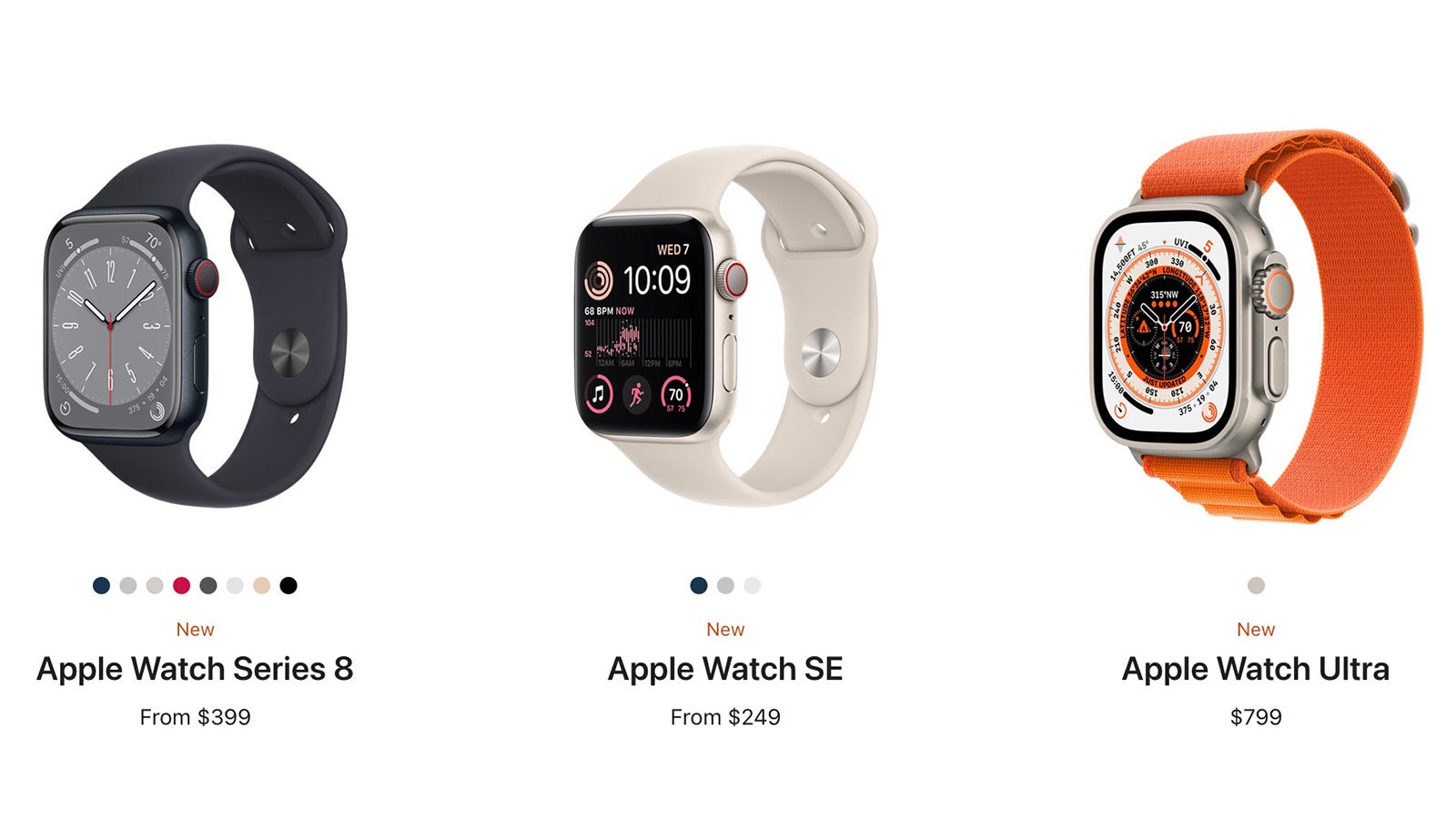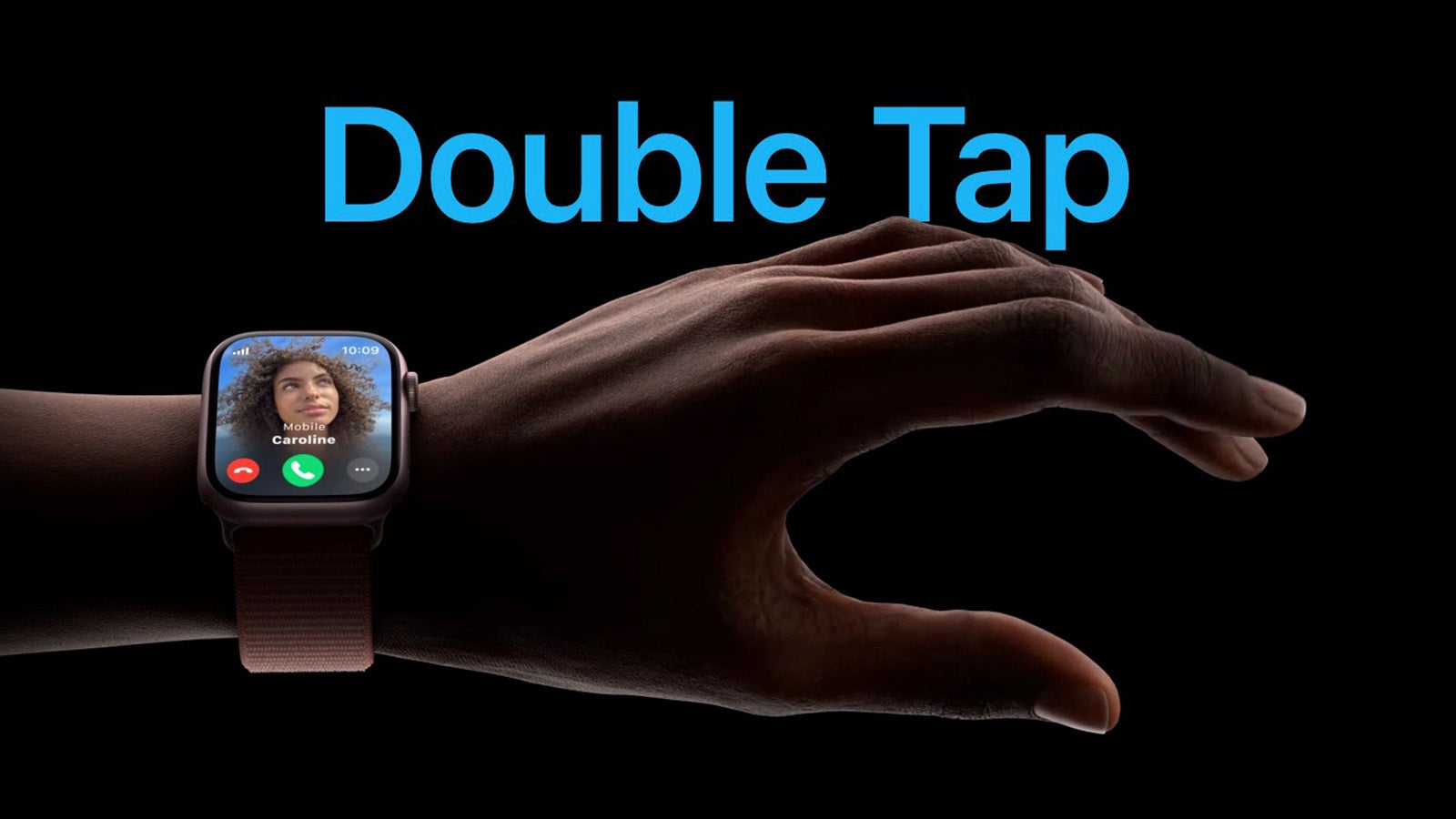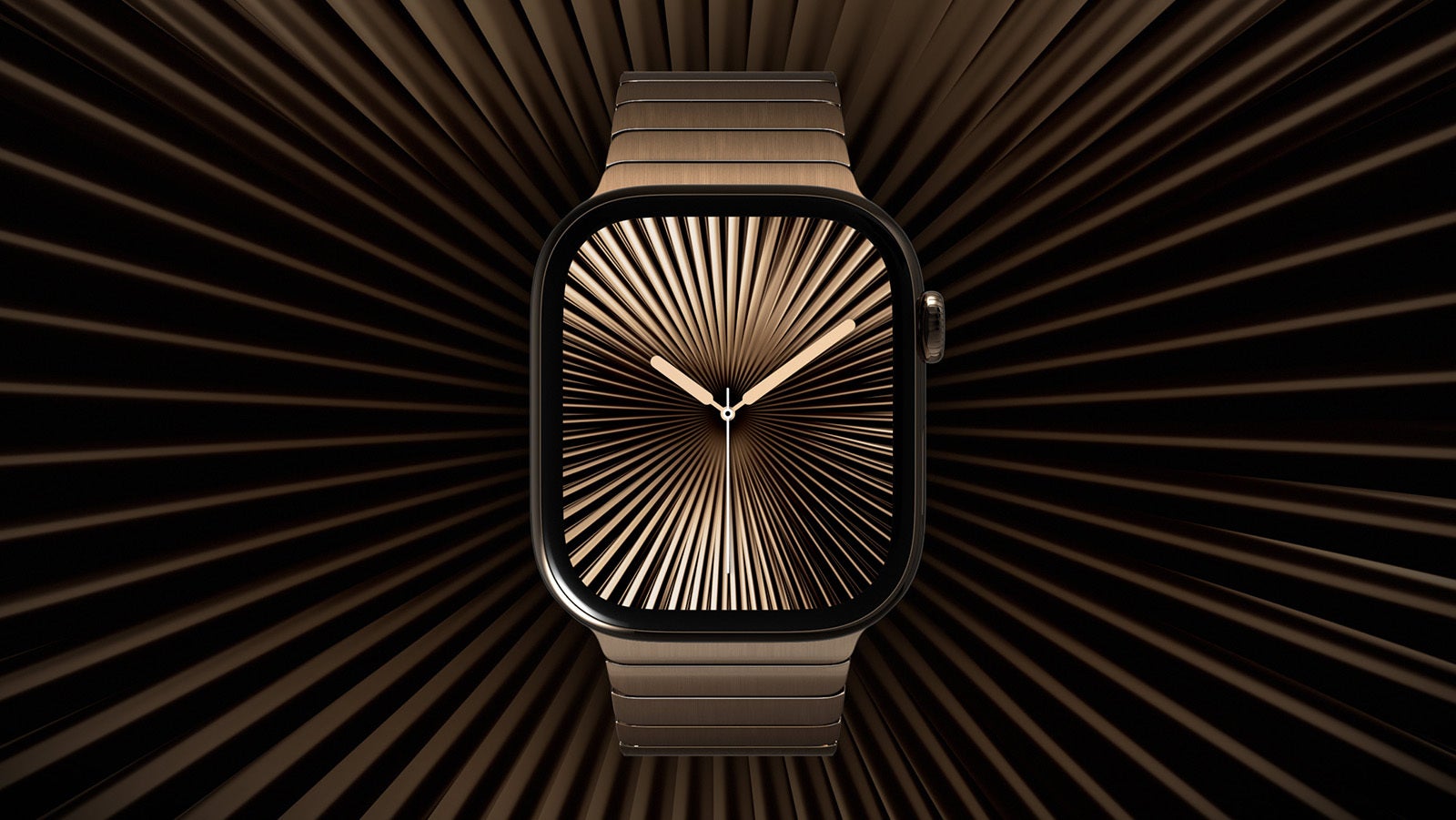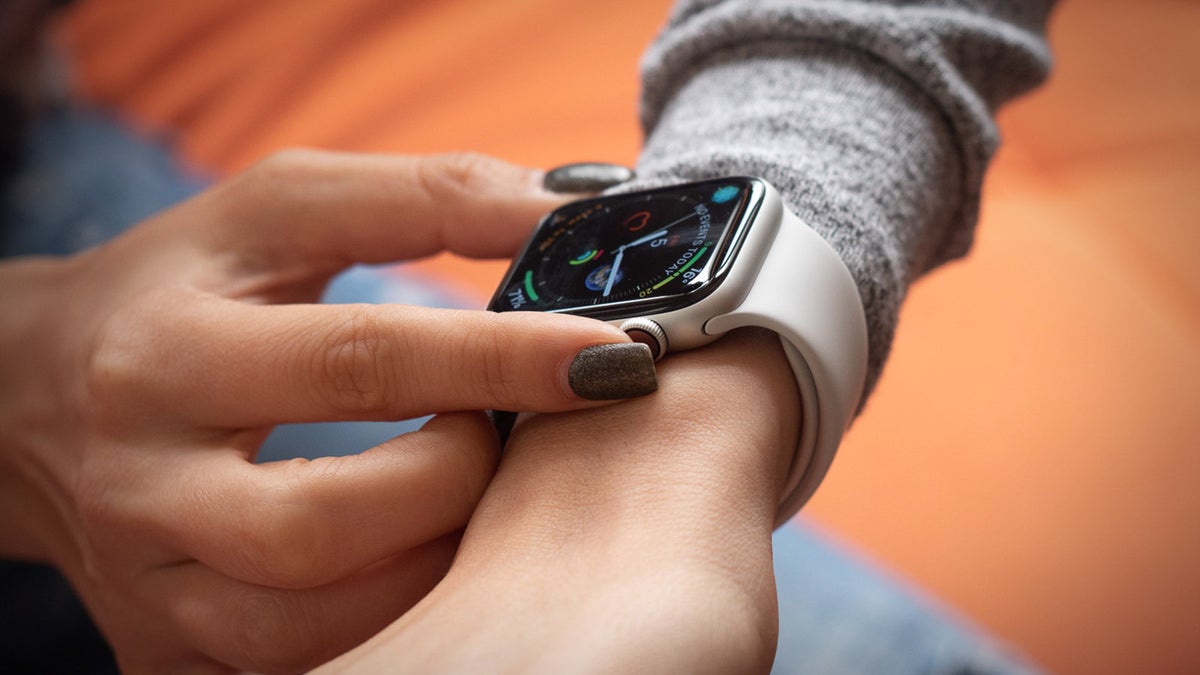So… let’s get started with this list of the history of the Apple Watch!
Quick links:
Apple Watch
Key features:
- Rectangular form factor
- OLED display
- 38mm/42mm sizes
- Optical heart rate sensor
- Easily interchangeable band system
- watchOS interface
- Activity rings
- Support for third-party apps
- Taptic Engine
- 18-hour battery life
- Only works with iPhones
- $350 / $400 price
The original Apple Watch, retrospectively referred to as the Series 0, set a solid foundation for Apple to build on. Unlike other companies that tried different formats of watches, Apple set on a steady course that it hasn’t changed: a rectangular watch available in two sizes, including a smaller size that other smartwatch makers were often lacking.
The original Apple Watch also established the 18-hour battery life that Apple has been sticking with, and also the 3 Activity Rings system, which has proven quite addictive for health-oriented folks. Apple also revolutionized the way you switch bands with a much more convenient, albeit proprietary system that remains popular and very convenient until now.
The big problem with the very first Apple Watch, however, was the performance, which was clearly lacking. Interactions often took way too long to the point that it was often easier to whip out your iPhone and check something there rather than attempt to do that on your watch. There were also other things Apple got a bit wrong, and selling $10,000+ gold versions of the original Apple Watch that aged very quickly was a glaring example. But work was just starting on the next generations that built upon this foundation and they fixed a lot of those flaws.
Apple Watch Series 1
New features:
- Upgraded to a dual-core processor (50% faster than S0)
- watchOS 3
- Lower price of $269
More than a year after the launch of the original, Apple introduced a renovated version that is referred to as Series 1 that arrived at a much lower price point AND fixed the biggest problem with the original — its slow speed. With a new dual-core processor that was 50% faster than the original, the Series 1 was bound to be successful.
Apple Watch Series 2
New features:
- Dual-core processor (50% faster than S0)
- Adds GPS sensor
- Water protection for swimmers (up to 50 meters)
- Brighter OLED display
- Breathe app
At the same time with the Series 1 which was a renovation of the original, Apple also introduced the Series 2 which added important features like a GPS sensor and water protection that allowed you to swim in a pool with the watch.
It also introduced the Breathe app, meant to help users calm down from a busy day, and that would become another signature experience that other watch makers would later copy.
Apple Watch Series 3
New features:
- Optional LTE connectivity via eSIM (plus $10 monthly carrier fee on top of your cell phone bill)
- New and faster S3 processor, more RAM
- Barometric altimeter for elevation tracking
- Siri now able to speak on the watch
The Apple Watch Series 3 was released exactly a year after the Series 2 setting the watch family on a steady path to yearly updates, just like the iPhone. It was a breakthrough product: the first one with independent cellular connectivity, so you could leave your phone at home and take calls directly from the watch. That cost a bit more for the watch and you had to pay a $10 monthly fee with your carrier, but it was a revolution for those who did not want to carry their phones with them everywhere.
Apple proved that it had taken the complaints about slow interactions on the watch seriously, and had another new processor that would further increase performance, so that finally the watch felt hickup-free.
Apple Watch Series 4
New features:
- ~30% larger screen, smaller screen borders
- ECG
- Faster S4 chip, up to 2X performance compared to S3
- W3 chip with Bluetooth 5.0
- Fall detection
- Digital Crown gets haptic feedback
By the time the Series 4 launched, speed was fixed and the most requested feature had become an always-on option. The Series 4 did NOT add that, but it had improved the design and the Series 4 came with larger screen sized — 40mm (up from 38mm) and 44mm (up from 42mm). This meant a lot more screen in the same form factor and looked modern and cool.
Apple continued innovating in silicon on the Series 4 which also received a faster processor as well as a brand new W3 chip with Bluetooth 5.0 connectivity.
A big new health feature was the ability to take ECG (electrocardiograms) straight from your wrist. These would provide you with an inside on your heart that could warn you about the onset serious illness, or even death. One very useful new feature was Fall Detection, which would automatically detect if a person falls (this was aimed mostly at the elderly, but not only), and dial an emergency contact. This was the first big push towards the Apple Watch becoming a health guardian as Apple would later put it.
Apple Watch Series 5
New features:
- Always-on display
- Compass
- Emergency Calling
- More storage, 32GB on board
- Ceramic “Edition” model
- Better ambient light sensor
The Series 5 finally added the most requested feature by users: an always-on screen! This required a brand new screen technology called LTPO that allowed the screen to refresh very slowly when not used (at 1Hz) and ramp up automatically to the standard 60Hz when you are using it.
At the same time, Apple managed to keep the same 18-hour battery life that the Apple Watch was known for and it added an additional compass for more accurate location visualization.
Apple Watch Series 6
New features:
- Blood Oxygen (SpO2) tracking
- New S6 chip with 20% faster performance than S5 and S4
- Sleep tracking
- Brighter screen (up to 2.5X)
- Force Touch removed
- New Red and Blue colors
- Updated heart rate sensor, 5GHz Wi-Fi connectivity support
The Series 6 was one of the less remarkable updates as it kept the same design styling and performance power as the Series 5 from the previous year.
The major new feature that Apple advertized was an SpO2 sensor that would measure your blood oxygen levels, which could theoretically predict the onset of illness or be a useful indicator for certain occupations like pilots.
It also added sleep tracking in a very basic form and the screen on the watch was a bit brighter for a more comfortable outdoor use.
Apple Watch SE
Key features:
Launched alongside the Series 6, the Apple Watch SE was essentially a rebranded Series 3. So why would you buy the Apple Watch SE? It was missing the convenient always-on display from the Series 5, as well as health features such as the ECG sensor and the blood oxygen sensor.
What it got right, though, was price: the SE started at just $280, quite a discount from the $400 cost of the flagship watch. Also, for the first time in an Apple Watch, upgrading to a cellular model that you could use independently of your phone cost just $50 extra, half the price such an upgrade used to cost before.
Apple Watch Series 7
New features:
- Slightly larger screens at 41mm and 45mm
- Smaller borders around screen
- 33% faster charging (requires new cable included with the watch)
- On-screen keyboard for typing
- IP6X certified for dust resistance
In 2021, Apple introduced the Series 7 just as expected in September, and despite persistent rumors of a new design, the watch looked almost exactly as previous ones. What had changed were the screen sizes as the company reduced the border around the screens even further, freeing space for a 41mm small size (vs 40mm before) and 45mm larger size (vs 44mm before). All of that was done while maintaining similar dimensions for the watch itself and also while preserving support for older bands.
The other new feature here was fast charging that now enabled users to top up the watch for 15 to 20 minutes in the morning instead of waiting for hours for a full charge. That would provide enough battery juice and still allow for effortless sleep tracking at night.
Apple Watch Series 8, Watch SE (2022) and new Apple Watch Ultra
September 2022

New features:
- Advanced cycle tracking on Series 8
- Brand new Apple Watch Ultra with 2-day battery life
- Thermometer on both S8 and Ultra
Apple officially unveiled the Apple Watch Series 8 in September 2022, and the changes from the previous generation are minimal.
The one most notable new feature in the Series 8 is a temperature sensor. If we have to be precise, there are two temperature sensors on the Series 8 and the Ultra, one on the bottom part and a second one under the screen. However, this cannot be used like a regular thermometer to measure skin temperature on demand. Instead, Apple uses this sensor while you sleep, measuring your temperature every five seconds, and then you can see your baseline temperature and changes. You can also turn this feature off, if you prefer to do so.
Read more:
Apple Watch Series 9 and Apple Watch Ultra 2


New features:
- New Double Tap gesture on Series 9 and Ultra 2
- New S9 SiP on both
- 2000-nits max brightness on Series 9, 3000 nits on Ultra 2
- Improved minimum brightness (1 nit)
- 2nd gen UWB chip
- Siri can now access and record Health data
- New pink case for Series 9
- New watch bands
- Smaller boxes, carbon neutral overall production
The two stand-out features are the new S9 chipset, the first upgrade on Apple Watches in years, and the new Double Tap gestures which allows you to tap your thumb and index finger to perform a number of actions that previously required touching the screen.
You also have a brighter screen, a new pink case, new UWB 2nd gen chip for better precision finding of lost items, as well as faster Siri that can now answer many of your requests without connecting to the Internet.
Unfortunately, the most requested new feature – improve battery life – did not materialize. The Series 9 is still rated for 18 hours of battery life (or double that if you use the Low Power Mode). If you want an Apple Watch with multi-day battery life, your only option remains the big and bulky Apple Watch Ultra 2.
Apple Watch Series 10


While we were all hoping for some major changes for the tenth anniversary Apple Watch, we are getting yet another year of minor improvements.
Chief among them is a bigger size for both models, so the Series 10 now come in 42mm and 46mm.
You still have a base aluminum model, but then the pricier option is no longer stainless steel, but instead made of lighter titanium.
The other notable change is faster charging as you now get 80% charge in just 30 minutes (it took 45 minutes on the Series 9).
The rest are smaller touch-ups: the screen has better viewing angles, you can now play music via the loudspeakers, and you get a water temperature sensor and a depth gauge.
Apple Watch Series 11
Expected in September 2025
It is still too early to know much about the Apple Watch Series 11, but it seems like it will be yet another minor upgrade, consider how Apple presented the Series 10 as a bigger change (it really wasn’t quite that though).
One feature that Apple has been developing for years is blood pressure monitoring, but the company has run into technical difficulties with this feature, so we don’t have high hopes that it will be ready for the Series 11.
We will be updating this section as we learn more, so stay tuned.
